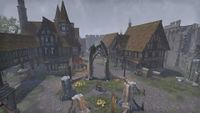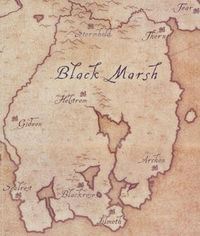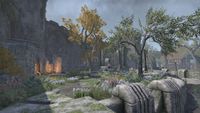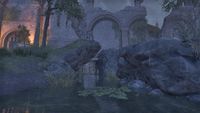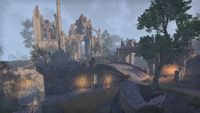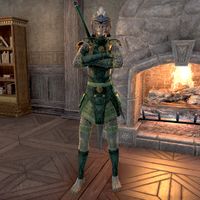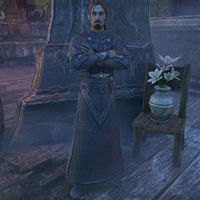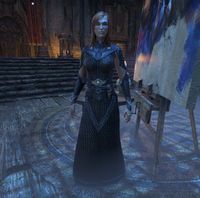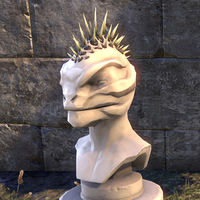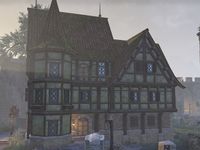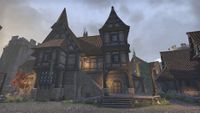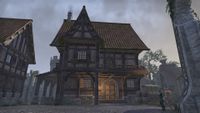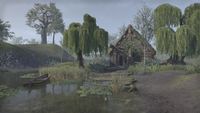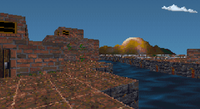Lore:Gideon
| Gideon | |
|---|---|
| Type | Settlement |
| Continent | Tamriel |
| Province | Black Marsh |
| Region | Blackwood (Gloomire) |
| Appears in | Arena, ESO |
Gideon is one of the eight major cities in the province of Black Marsh,[1] situated in the flooded hillscape of Blackwood. Gideon is a sleepy frontier town that serves as a gateway to the greater and treacherous expanse of the province,[2] but it also hosts a melting pot of cultures, from the modern-day Imperials of the Nibenay and the Argonians of Blackwood, to the Barsaebic Ayleids and the Kothringi that formerly lived in the region.[3] Gideon is often visited and settled by hunters, dealers in herbs, and other professions that seek out Black Marsh's wonders.[2] Back when it was an Ayleid city, it was known as Twyllbek.[4]
Contents
Layout & Geography[edit]
From the main city of Leyawiin, the town of Gideon is the first settlement on the Blackwood Road, which comes in from the west through the hills that form the southernmost provincial border. The city is surrounded by steep and lightly forested hills to the west and the humid marshland to the northeast, the latter of which floods in from Lake Blackwood to the north. Much of the region is largely uninhabited, save for the derelict plantations and the lifeless orchards overseen by the Archeins serfdoms.[5] The region has its fair share of danger, such as the fact that it has a notably large population of death hoppers, or that the haunted ruins of Castle Giovesse are just in arm's reach from the north gate.[2] The Kothringi lived in large numbers in the Gideon region but after their untimely death in the Second Era, their land became vacant and became a trade route between Gideon and Leyawiin.[6] Gideon is neighbored by several settlements, including Glenbridge to the northeast, Stonewastes to the southeast, and the Imperial Province to the west,[1] toward the Imperial City.[7]
Through the city is a large thoroughfare called Blackwood Way that forks on the region's main road from Gideon's gate. Most of the city's buildings are located on this road because it's the only dry ground left through Gideon, so important structures such as the Temple of Dibella and the Governor's Mansion can be found here.[2] While the main road is large and spacious, the streets of Gideon are described as cramped and labyrinthine.[8] Speaking of the latter, it is the city's seat of power and administrative center, occupied by the Imperial Governor.[2] Even though the city is built majorly in the Imperial architectural style, much of Gideon makes use of the ancient Ayleid ruins, such as the city plaza and especially the city gardens to the south, even so, there are sections of the ruins closed from the public.[2] Some of the lowlifes of Gideon excavated and built an underground arena called the Ruction Ring.[9]
Notable Locales[edit]
|
|
|
History[edit]
Early History and the Second Empire[edit]
Before the town was built, there was an Ayleid city called Twyllbek. It was built by the Aedric-worshipping Barsaebics that fled Cyrodiil after the Narfinsel Schism, back in the late Merethic Era.[10] Their humiliation after the event had stuck with them for many years, even when the Alessian Slave Rebellion took place in 1E 242. This was well evident in the King of Twyllbek's response to an envoy sent by King Glinferen of Atatar, who was at the helm of the Daedraphile's movement during the Narfinsel Schism. The Barsaebic King, whose name is lost to time, gave a rather blunt refusal and left his former enemies to fend for themselves.[11] Because of their city's location and how far removed, culturally they were from the Heartland Elves, the Ayleids of Twyllbek were spared the wrath of Queen Alessia and her Nedic rebels.[12]
It is unknown when the Ayleids died out in Gideon, but by the latter First Era, the site was occupied by the Nibenese-Imperials and Castle Giovesse was built on the outskirts to the north. The castle was the seat of a duchy that was first occupied by Lord Calvus Vanin.[13] For most of history after that, Gideon was a sleepy, frontier garrison town but it saw a lot of attention with the Blackwater War and the Second Empire, back in the late First Era. As Emperor Reman II set forth his plans to advance Imperial interest into Black Marsh, the Nibenese of eastern Cyrodiil came in droves to inhabit the frontier, as the Imperial Legion built roads and fortifications around Gideon.[2] The town was caught in the chaos of the Great Burn, in early Rain's Hand in 1E 2828, a massive fire that started from across the province near Stormhold.[14] The third campaign of the Blackwater War was helmed by General Lucinia Falco and the Fourth Legion, who were stationed in Gideon in 1E 2833.[15]
Tavia's Imprisonment and Gideon in the Interregnum[edit]
After the Blackwater War and Black Marsh's annexation into the Second Empire, the town became a proper and wholly Imperialized township, and by Reman III's reign, Castle Giovesse imprisoned the Emperor's former wife, Empress Tavia over accusations of treason in 1E 2899.[12]
Tavia's imprisonment and her knight, Zuuk's exploits in Gideon became a central and recurring set piece in the famous historical-fiction, 2920, The Last Year of the First Era. And while it is known that Tavia used her time in Castle Giovesse to undermine the Emperor's reign,[2] the fictional book, 2920 claims that the Empress' plot had inadvertently caused the death of her son and the Crown Prince, Juilek in Dorsza Pass,[8][16] and she committed suicide upon learning the news on Hearthfire in 1E 2920.[17] By the Second Era, Gideon was ruled by the Imperial Governor, a title often given to the nobles of western Blackwood. By the sixth century, this title was passed between the Nibenese Imperials of House Vandacia and House Martius.[2]
By roughly 2E 534, the title of Councilor in Gideon was held by Ertus Vandacia, but because of his support in Durcorach's rise to power in the Interregnum, he was given a position in the Elder Council and moved to the Imperial City.[18] In his stead, the role of Imperial Governor was given to Lord Parnon Martius, whose reign lasted for an unknown time. At around the same time as Lord Vandacia's ascension to the Elder Council, Lady Dorcia Martius passed away and relinquished her home, a manor-house on Blackwood Way to the House of Dibella, who converted it into a Temple of Dibella,[2] or more specifically, a Dibellaseum.[19] When the Planemeld took place several years later, Councilor Vandacia was back home in Gideon to deal with the iron crisis in the Nibenay Basin.[20]
Shortly afterward, the Three Banners War enraptured central Cyrodiil and after two years of service, the Ebonheart Pact's leading general, Keshu the Black Fin and her Black Fin Legion retired to Gideon, bringing artisans and crafters and ruling as Governor. Using her experience traveling the Pact's major regions, Keshu hoped to turn Gideon into a welcoming gateway into Black Marsh's greater culture and history.[21][22] After the collapse of the Empire, Councilor Vandacia stayed in Gideon and his family holdings to serve as Keshu's advisor and bureaucrat.[23][24] As of the 2E 582, Gideon and Topal Bay region were independent from Leyawiin. Gideon and Leyawiin had a trade agreement and it caused traffic in ancestral Kothringi land.[6][22]
Vandacia and the Four Ambitions[edit]
In 2E 582, the Order of the Waking Flame had set forth their plans to acquire the Four Ambitions, just as it was ordered by Emperor Leovic. After several members of the Elder Council were supposedly murdered by the Dark Brotherhood, Captain Rian Liore of the Ivory Brigade sent an adventurer to warn Councilor Vandacia but found that the Black Fin Legion had captured their Brotherhood assailant, Elam Drals and placed him in custody underneath the courthouse. But before he could have been interrogated, Elam escaped into the Twyllbek Ruins and was in hot pursuit by the adventurer. Eventually, the two reconciled in the ruins and Elam denied any involvement in the murders.[25]
When it was later revealed that Vandacia was behind the murders as well as the Order of the Waking Flame, the adventurer and their ally, Eveli Sharp-Arrow returned to Gideon to learn more about a location mentioned in an encoded journal, Ojel-Bak from Governor Keshu.[26]
The two made their way to the natural formation, Ojel-Bak, deep in Sul-Xan territory, and returned to Gideon with two of the Four Ambitions, the twins, Calia and Destron.[26] They decided to leave the twins in Keshu's care and after an excursion into Vandacia's get-together in the Deadlands, they brought over the third ambition Sombren.[27] Vandacia eventually learned that three of the Four Ambitions were hiding in Gideon and gathered the cult around the city for a large-scale attack. But before he was able to advance, the ambitions were relocated northwest to a repurposed Fort Redmane on the Lower Niben, primarily guarded by the Black Fin Legion and other allies.[28] The battle in Fort Redmane was victorious but at the expense of Destron's life. While Sombren and Calia left the city to train uninterrupted, the celebration took place in Gideon's city gardens. Councilor Tarnian Lovidicus of Leyawiin and Governor Keshu began to make plans to keep Blackwood's border and roads secure.[29]
Gideon and the Third Empire[edit]
During the Imperial Simulacrum in the late Third Era, the city-state of Gideon was an active settlement. It was ruled by Queen Demia and had a rivalry with Soulrest. Back in that time, the followers of Seth held vast control over the city and a foreboding chill engulfed the town.[30] Years later in 4E 48, Gideon was overrun by the undead forces of Umbriel, the floating city from Oblivion despite the fact it was nowhere near its line of trajectory.[31]:42 Gideon's destruction was considered light compared to other locations on its path.[31]:44 Later in the Fourth Era, Gideon was an active settlement.[32]
Known Rulers[edit]
- The First Era
- The Second Era (The leader of Gideon at the time was either called the Imperial Governor or the Vicecanon)[2][33]
- The Third Era
Culture and Society[edit]
- For Argonian culture as a whole, see the: Culture section on the Argonian page.
Gideon is mostly populated by Argonians that have grown accustomed to Cyrodilic customs and trade, otherwise known as Lukiul. They are well versed in the Cyrodilic language and conducted business subtly with great success. But with their affinity for Cyrodilic customs and know-how, it comes with a cost as they lean away from Argonian philosophy and traditions.[3] For most of its time, the city has been a shadow of its prime but when the war hero, Keshu the Black Fin took control of Gideon,[2] she aimed to convert the city into a welcoming gateway into the intricacies of Argonian culture.[3] And through Gideon, hopefully, revitalize Argonian culture to what it once was before the days of Duskfall.[21]
The Nibenese of Gideon share the regional Kothringi's devotion for Dibella, and at the center of their veneration is the local House of Dibella in the city's main thoroughfare. They occupy the former town manor of Lady Dorcia Martius, a wealthy aristocrat and devotee of the Lady of Love.[2] It is a Dibellaseum, a consecrated love-nest[19] and at some point in time, it hosted a Sibyl of Dibella.[6]
Unruly Argonian teenagers in the bad parts of Gideon would sometimes fashion their head crests into multiple spikes.[35] Since the Argonians of Gideon have dealt with the other races more than other tribes, they know what sort of swamp cuisine they can stomach and cater to them accordingly.[2] The Glowgill Guar of Gideon and even Murkmire are visually distinct by their golden-colored scales. Instead of calling them the Golden Glowgill Guar, they shorten it to the Ambergill Guar.[36] The Rootworm travels south toward Gideon during the wintertime migration as part of the Underground Express. Gideon's stop is marked by the abundance of red clay.[5] The town has warm mud-bathhouses.[37]
Gallery[edit]
Notes[edit]
- In the Imperial Simulacrum, there was an active temple called the Brotherhood of Gideon. How it is related to the city, other than its shared name is currently unknown.[38]
- Some sources in lore suggest that Gideon is located in Murkmire.[33][6] The reason for this discrepancy is because the Murkmire zone in ESO was originally going to be located in western Black Marsh, adjacent to Shadowfen and encompassing the city of Gideon. The zone was delayed and redesigned, resulting in Murkmire being moved to southern Black Marsh and Lilmoth replacing Gideon as the region's main settlement.
- Arena was originally conceived as a fighting game featuring a tournament that took the player to each of Tamriel's cities to challenge different gladiatorial teams. According to a file from that stage of development left behind in the final game, Gideon's gladiatorial team would have been called "the Shadowblades".[UOL 1]
See Also[edit]
- For game-specific information, see the Arena and Elder Scrolls Online
 articles.
articles.
Books[edit]
- Before the Gates of Gideon by Wud-Selas — Historical fiction about an Argonian attack on Gideon during the Blackwater War
- Traveler's Guide to Gideon by Astinia Isauricus; Published 22 Frost Fall, 2E 570 — An overview of Gideon's people, history and notable places
- Tribes of Blackwood: Gideon and the Border by Emmanubeth Hurrent, the Wayfarers' Society of Wayrest — An overview of the Argonians of Gideon
References[edit]
- ^ a b Map of Black Marsh – The Elder Scrolls: Arena
- ^ a b c d e f g h i j k l m n o p q r Traveler's Guide to Gideon — Astinia Isauricus; Published 22 Frost Fall, 2E 570
- ^ a b c Tribes of Blackwood: Gideon and the Border — Emmanubeth Hurrent, the Wayfarers' Society of Wayrest
- ^ Twyllbek Ruins sub-location in ESO: Blackwood
- ^ a b The Argonian Account, Book 3 — Waughin Jarth
- ^ a b c d Augustine Viliane Answers Your Questions — Sibyl Augustine Viliane
- ^ Map of the Imperial Province – The Elder Scrolls: Arena
- ^ a b 2920, Second Seed — Carlovac Townway
- ^ Ruction Ring sub-location in ESO: Blackwood
- ^ Ayleid Survivals in Valenwood — Cuinur of Cloudrest, 4th Tier Scholar of Tamrielic Minutiae
- ^ a b Chancellor Abnur Tharn Answers Your Questions — Chancellor Abnur Tharn
- ^ a b Pocket Guide to the Empire, 3rd Edition: The War with the Trees: Argonia and the Black Marsh — Imperial Geographical Society, 3E 432
- ^ Duchess Astella Galenus' dialogue in ESO: Blackwood
- ^ The Blackwater War, Volume 6 — Valenca Arvina, Historian-in-Residence at Gwylim University
- ^ a b The Blackwater War, Volume 7 — Valenca Arvina, Historian-in-Residence at Gwylim University
- ^ 2920, Last Seed — Carlovac Townway
- ^ 2920, Hearth Fire — Carlovac Townway
- ^ a b Imperial Decree Regarding the Elder Council
- ^ a b Faric Gemain's dialogue in ESO: Blackwood
- ^ Minutes of the Elder Council
- ^ a b c The Black Fin Comes Home — Mee-See, Squire and Personal Aide to Keshu the Black Fin
- ^ a b c Keshu the Black Fin's dialogue in ESO: Blackwood
- ^ Meet the Character(s) - The Elder Council — Adandora, Chronicler-at-Large
- ^ Councilor Vandacia's dialogue in ESO: Blackwood
- ^ A Deadly Secret story quest in ESO: Blackwood
- ^ a b A Hidden Vault story quest in ESO: Blackwood
- ^ A Mysterious Event story quest in ESO: Blackwood
- ^ Pyre of Ambition story quest in ESO: Blackwood
- ^ Heroes of Blackwood story quest in ESO: Blackwood
- ^ a b Gideon location and rumors in Arena
- ^ a b Lord of Souls — Greg Keyes
- ^ Talen-Jei's dialogue in Skyrim
- ^ a b Heita-Meen Answers Your Questions — Vicecanon Heita-Meen
- ^ Exiled from Exile, Volume 7 — Yasra al-Ash'abah
- ^ Multi-Spined Skull Crest hairstyle description in ESO
- ^ Ambergill Guar mount description in ESO
- ^ Travels Around the Western Holds — Inky-Claws
- ^ Brotherhood of Gideon temple in Arena
Note: The following references are considered to be unofficial sources. They are included to round off this article and may not be authoritative or conclusive.
